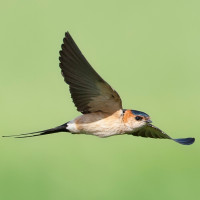Description
This area is the upper part of the marshes of the Palmones river. It is limited by the main river to the south, the Guadacorte river to the north and the A7 motorway to the west. The eastern part has some marshes that are often partially flooded. The rest only have flooded areas when it rains. The interest of this area is that it has some habitats that do not exist in the marshes and that complement them perfectly. These habitats are floodplain grasslands, riverside vegetation, and wild olive tree forest. This combination of forest, scrub and open areas, along with two rivers, is very attractive for birds, especially during migration and in winter. For example, at the end of March 5 species of pipits have been seen at the same time, ľabtuška lúčna, ľabtuška vrchovská and ľabtuška veľká, as wintering, and ľabtuška hôrna and ľabtuška poľná in migration.
The eastern waterlogging area, due to tides, is used by waders and other birds to feed at high tide or rest. Species such as volavka popolavá, kršiak rybár or sokol sťahovavý use the cleared surfaces to rest or feed, especially in winter, where, in addition, you can see, among others, drozd plavý or vrchárka modrá in the forests. Among the species that can be found in summer are sokol bielopazúravý, which come here to hunt from Los Barrios, ľabtuška poľná or trasochvost žltý. rybárik riečny is present all year round, as well as myšiak hôrny, and sometimes specimens of the so-called Gibraltar buzzards (hybrids between myšiak hôrny and myšiak hrdzavý) are observed. It is the only site in the province with regular wintering of ľabtuška veľká and rare and hard to find species have been seen in the region of the Campo de Gibraltar such as krakľa belasá or strakoš prieložný.
During the migration periods it is possible to see a huge variety of trans-Saharan passerines with some easy-to-find species such as penica záhradná, skaliarik sivý, trsteniarik malý and kukučka obyčajná. It’s also a good place to see daylight migration species like raptors, storks, swifts, swallows, martins or bee-eaters, mainly with the west winds.
Details
Access
It is accessed from the A7 motorway. If you are heading towards Malaga-Algeciras, you must make a U-turn taking exit 109. Once on the motorway, now as if you were heading towards Algeciras-Malaga, continue on the right-hand lane and take the second exit 110B ( not the 110A that goes to ZAL Area del Fresno) that indicates Los Barrios, Jerez and Seville. At about 300 meters from the sign you have to be very careful because there is a hole on the right through which you have to exit the highway. It is very important to go slowly and even signpost the manoeuver in time because it is a bit dangerous. You enter an old road, now unused, that you have to travel to the end (about 600 meters). There you can park the car and continue on foot.
